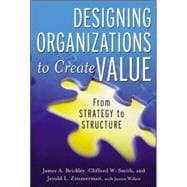
What is included with this book?
James A. Brickley, Ph.D., is the Gleason Professor of Business Administration at the University of Rochester's Simon Graduate School of Business. He has coauthored a number of influential books, and his work has appeared in numerous professional journals, including The Journal of Business and The Journal of Finance.
Clifford W. Smith, Jr., Ph.D., is the Louise and Henry Epstein Professor of Business Administration at the Simon Graduate School of Business. He is the author or coauthor of more than a dozen books and numerous journal articles and has served as an economist with the Securities and Exchange Commission.
Jerold L. Zimmerman, Ph.D., is the Ronald L. Bittner Professor of Business Administration at the Simon Graduate School of Business. The author or coauthor of several books, he is a founding editor of the Journal of Accounting and Economics and has (along with coauthors Brickley and Smith) extensive corporate consulting experience.
Janice Willett is a senior manuscript editor with the Journal of Financial Economics and associate editor of the Journal of Applied Corporate Finance.
| Preface | ix | ||||
|
1 | (18) | |||
|
2 | (5) | |||
|
7 | (1) | |||
|
8 | (3) | |||
|
11 | (1) | |||
|
12 | (4) | |||
|
16 | (3) | |||
|
19 | (24) | |||
|
20 | (2) | |||
|
22 | (2) | |||
|
24 | (1) | |||
|
25 | (2) | |||
|
27 | (6) | |||
|
33 | (3) | |||
|
36 | (2) | |||
|
38 | (2) | |||
|
40 | (3) | |||
|
43 | (22) | |||
|
43 | (1) | |||
|
44 | (6) | |||
|
50 | (5) | |||
|
55 | (4) | |||
|
59 | (6) | |||
|
65 | (30) | |||
|
66 | (2) | |||
|
68 | (2) | |||
|
70 | (10) | |||
|
80 | (2) | |||
|
82 | (5) | |||
|
87 | (5) | |||
|
92 | (3) | |||
|
95 | (28) | |||
|
96 | (1) | |||
|
97 | (6) | |||
|
103 | (8) | |||
|
111 | (2) | |||
|
113 | (4) | |||
|
117 | (6) | |||
|
123 | (28) | |||
|
124 | (1) | |||
|
125 | (3) | |||
|
128 | (2) | |||
|
130 | (4) | |||
|
134 | (2) | |||
|
136 | (7) | |||
|
143 | (2) | |||
|
145 | (4) | |||
|
149 | (2) | |||
|
151 | (32) | |||
|
152 | (1) | |||
|
153 | (10) | |||
|
163 | (14) | |||
|
177 | (6) | |||
|
183 | (26) | |||
|
184 | (1) | |||
|
185 | (7) | |||
|
192 | (3) | |||
|
195 | (6) | |||
|
201 | (8) | |||
|
209 | (22) | |||
|
210 | (1) | |||
|
211 | (2) | |||
|
213 | (3) | |||
|
216 | (1) | |||
|
217 | (1) | |||
|
218 | (2) | |||
|
220 | (3) | |||
|
223 | (3) | |||
|
226 | (2) | |||
|
228 | (3) | |||
|
231 | (26) | |||
|
232 | (2) | |||
|
234 | (5) | |||
|
239 | (5) | |||
|
244 | (4) | |||
|
248 | (2) | |||
|
250 | (7) | |||
|
257 | (24) | |||
|
258 | (4) | |||
|
262 | (3) | |||
|
265 | (6) | |||
|
271 | (6) | |||
|
277 | (1) | |||
|
278 | (3) | |||
| Sources | 281 | (14) | |||
| For Further Reading | 295 | (6) | |||
| Index | 301 |
The New copy of this book will include any supplemental materials advertised. Please check the title of the book to determine if it should include any access cards, study guides, lab manuals, CDs, etc.
The Used, Rental and eBook copies of this book are not guaranteed to include any supplemental materials. Typically, only the book itself is included. This is true even if the title states it includes any access cards, study guides, lab manuals, CDs, etc.